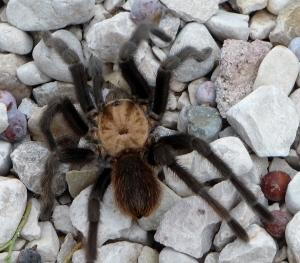Creepy Critters as Pets
- posted: Oct. 27, 2015

Non-Traditional Pets
Spiders, rats and snakes are the stuff of nightmares for some people, but did you know many people actually keep these animals as pets? Truth is if you know how to take care of them, they can make very interesting companions.
Did you know that there are over 800 different species of tarantulas? Several are commonly kept as pets including the Chilean Rose and Mexican Red Leg varieties. Tarantulas need little space and are relatively clean, but they are solitary animals and should be housed individually. Most sold as pets are females as they can live for more than 20 years. Males have a much shorter lifespan of two to five years. Tarantulas eat crickets and other insects and occasionally “pinkie” mice or small lizards. While they can be handled, it is recommended that owners limit handling to avoid injury to the tarantula—a fall from a height as little as three feet can rupture the spider’s abdomen and it will die. All tarantulas are venomous, but for most people, the bite is no worse than a bee sting. It will hurt, but not be fatal unless you are allergic to the bite. Many species also have hairs that they can shed to deter predators but which can be very irritating if they get into the skin or eyes or are inhaled. These unique pets are not for everyone, but some people enjoy keeping tarantulas as a hobby.
If you suffer from ophidiophobia, then a pet snake would not be for you; however, many people find snakes to be fascinating pets. Care and feeding depends largely on the species of snake you have, so, if you are interested in a pet snake, do your research on proper care of the particular type of snake you want before purchasing. Corn snakes and ball pythons often make good pets for first time owners. One factor that may make some people squeamish is that snakes need to eat other animals, usually mice or chicks. They can be live or killed/frozen, depending on what the snake is used to eating. Many handlers advocate feeding killed prey as live prey could actually injure the snake. Of course, snakes can bite people, but they can also carry Salmonella bacteria on their skin so you should also use good hygiene when handling snakes. Snakes may need to visit the veterinarian if they develop health problems like respiratory infections, injuries, parasites or mouth rot (a bacterial infection of the mouth).
Finally, rats and mice are often thought of as disease carrying pests, but many people love these small mammals as companions. Like tarantulas and snakes, they do not require large amounts of room, but unlike the others, rodents respond more to and are less easily injured by handling. Rats are thought to be very personable and even intelligent as rodent species go. Rats and mice can be fun to watch as they burrow, traverse a maze of tubes or use an exercise wheel. Rodents can be prone to a variety of illnesses and will sometimes form tumors. Captive born rats and mice are rarely a threat to humans, but some can carry diseases like rat bite fever and they can harbor fleas or cause minor injuries if they bite you.
So, if you are on the market for a unique pet, like the shock factor of having a pet that might creep most people out, or are a big fan of Halloween, these pets might be for you. But, remember to do your research and make sure you know how to properly care for a spider, snake or rat before you add one to your home.
Happy Halloween Everyone! Stay safe and keep your Halloween haul away from your pets!
This blog brought to you by the Patton Veterinary Hospital serving Red Lion, York and the surrounding areas.
Location
Patton Veterinary Hospital
425 E Broadway
Red Lion, PA 17356
